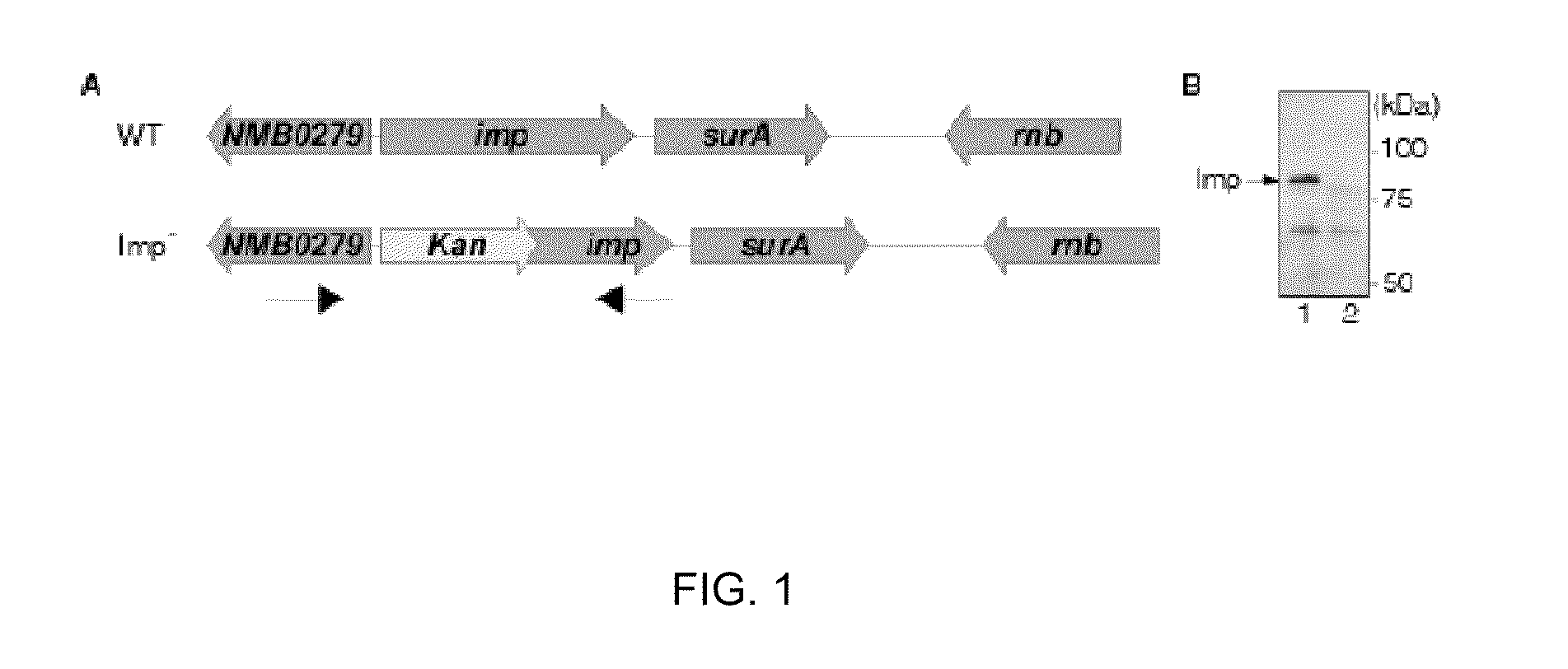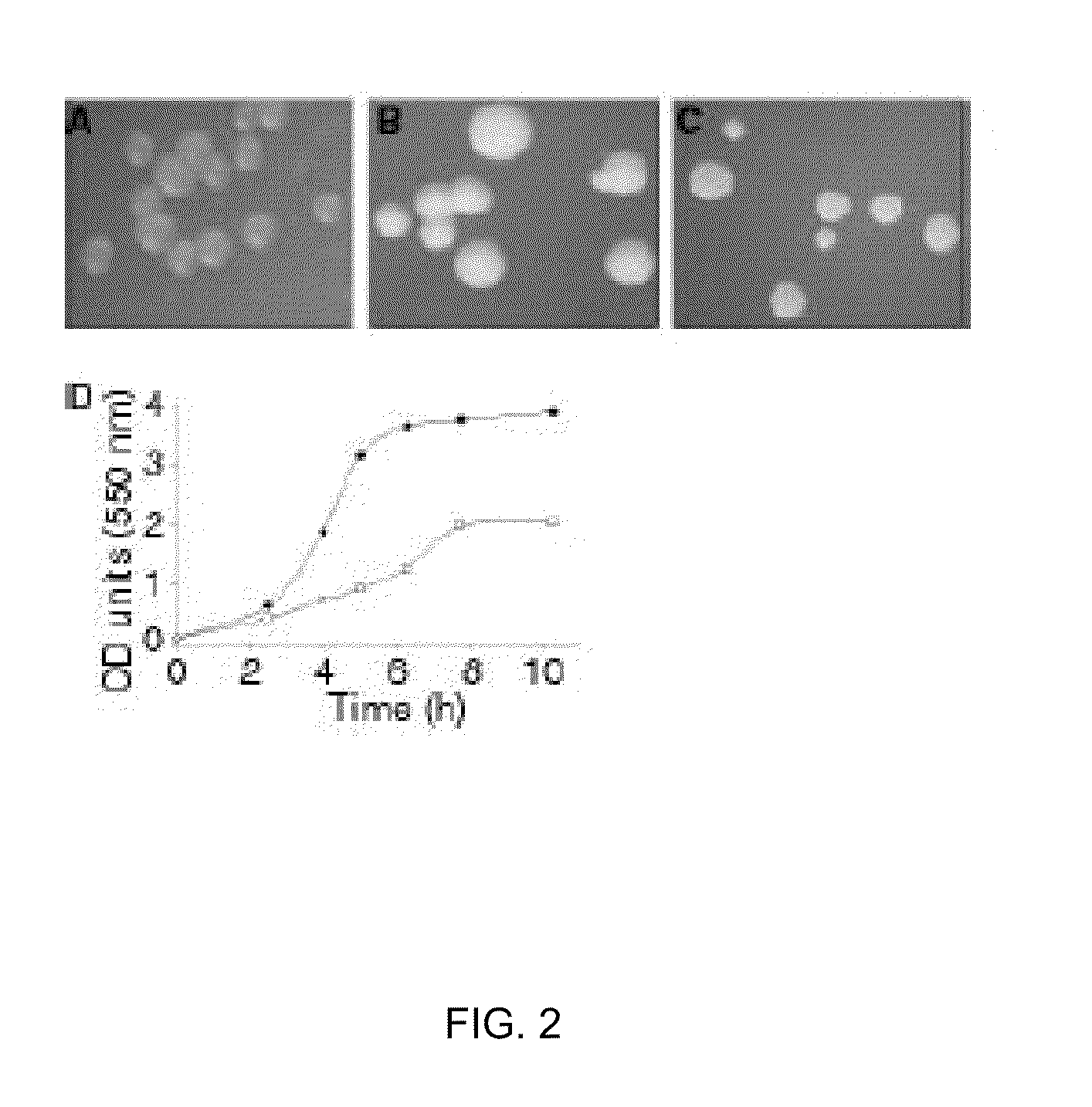Outer membrane vesicles and uses thereof
a technology of outer membrane and vesicles, which is applied in the field of outer membrane vesicles, can solve problems such as the rise of disease into a worldwide health problem
- Summary
- Abstract
- Description
- Claims
- Application Information
AI Technical Summary
Benefits of technology
Problems solved by technology
Method used
Image
Examples
example 1
General Methods
[0297]Bacterial Strains and Growth Conditions. Neisseria meningitidis (Nme) H44 / 76, a serotype B strain, came from our laboratory collection. The H44 / 76 lpxA mutant (Steeghs et al 1998; Nature 392; 449-450) and the H44 / 76 derived strain HA3003, where lpxA expression is controlled by the tac promoter (Steeghs et al 2001; EMBO J. 24; 6937-6945), were generously provided by L. Steeghs and P. van der Ley (Netherlands Vaccine Institute (NVI), Bilthoven, The Netherlands). Nme was grown on GC agar (Becton Dickinson) plates containing Vitox (Oxoid) and antibiotics when appropriate (kanamycin 100 μg / ml, chloramphenicol 5 μg / ml) in candle jars at 37° C. Liquid cultures were grown in tryptic soy broth (TSB) in plastic flasks at 37° C. with shaking. For sialylation experiments, 80 μM cytidine 5′ monophospho-N-acetyl neuraminic acid (CMP-NANA, Sigma) was added for 2 h to the medium of bacteria growing in mid-log phase. E. coli strains DH5 α or TOP10F′ (Invitrogen) were used for ro...
example 2
Imp is Not Essential in N. meningitidis
[0306]A Neisserial imp mutant was constructed by allelic replacement of the imp gene in strain H44 / 76 with a copy containing a deletion-insertion mutation (FIG. 1A). We used the sequence of NMB0279 and NMB0280 from strain MC58 to design primers to clone and subsequently delete the imp gene in Nme strain H44 / 76 (FIG. 1A). Briefly, part of the gene upstream of imp, NMB0279, was cloned from H44 / 76 DNA using primers A and B (Table 1). The 3′ end of the imp gene was obtained by PCR with primers C and D. Both PCR products were cloned into pCR2.1-TOPO (Invitrogen), resulting in plasmids pCR2.1-NMB0279 and pCR2.1-3′Imp. An AccI-XbaI fragment of pCR2.1-NMB0279 was ligated into AccI-XbaI restricted pCR2.1-3′Imp. The resulting plasmid was cut with AccI to allow insertion of a kanamycin-resistance cassette. This cassette was PCR amplified from plasmid pACYC177 (New England Biolabs) using primers E and F (Table 1), which introduced terminal AccI sites and ...
example 3
Phenotype of a Neisserial imp Mutant
[0310]A striking feature of the transformants was their intense colony opacity compared to wild-type colonies (FIG. 2A, B), a property also apparent for the LPS-deficient mutant (FIG. 2C). Furthermore, similar to the LPS-deficient strain (Steeghs et al 2001; EMBO J. 24; 6937-6945), the imp mutant bacteria grew slower and to a lower final optical density than wild-type bacteria (FIG. 2D). Analysis of the protein profiles of whole cell lysates (data not shown) or cell envelopes (FIG. 3A) in denaturing or semi-native SDS-PAGE showed no marked differences between wild-type and imp mutant bacteria. The major OMPs of Nme are the trimeric porins PorA and PorB. These trimers are very stable and do not dissociate into monomers during semi-native SDS-PAGE (Voulhoux et al 2003 Science 299; 262-265). When we analyzed cell envelopes of the imp mutant in semi-native conditions, most of the PorA protein was present in its trimeric form, as shown by immunoblottin...
PUM
| Property | Measurement | Unit |
|---|---|---|
| Tm | aaaaa | aaaaa |
| pH | aaaaa | aaaaa |
| pH | aaaaa | aaaaa |
Abstract
Description
Claims
Application Information
 Login to View More
Login to View More - R&D
- Intellectual Property
- Life Sciences
- Materials
- Tech Scout
- Unparalleled Data Quality
- Higher Quality Content
- 60% Fewer Hallucinations
Browse by: Latest US Patents, China's latest patents, Technical Efficacy Thesaurus, Application Domain, Technology Topic, Popular Technical Reports.
© 2025 PatSnap. All rights reserved.Legal|Privacy policy|Modern Slavery Act Transparency Statement|Sitemap|About US| Contact US: help@patsnap.com



